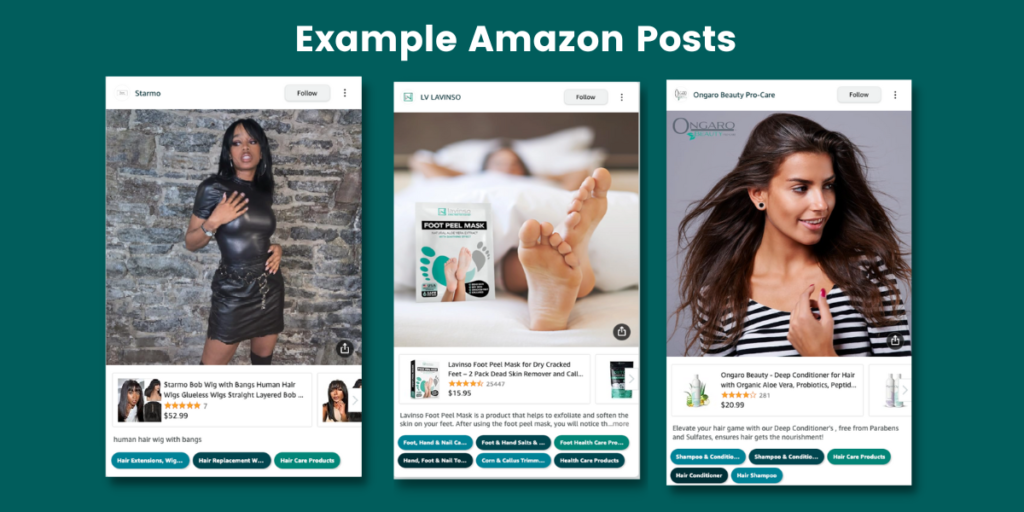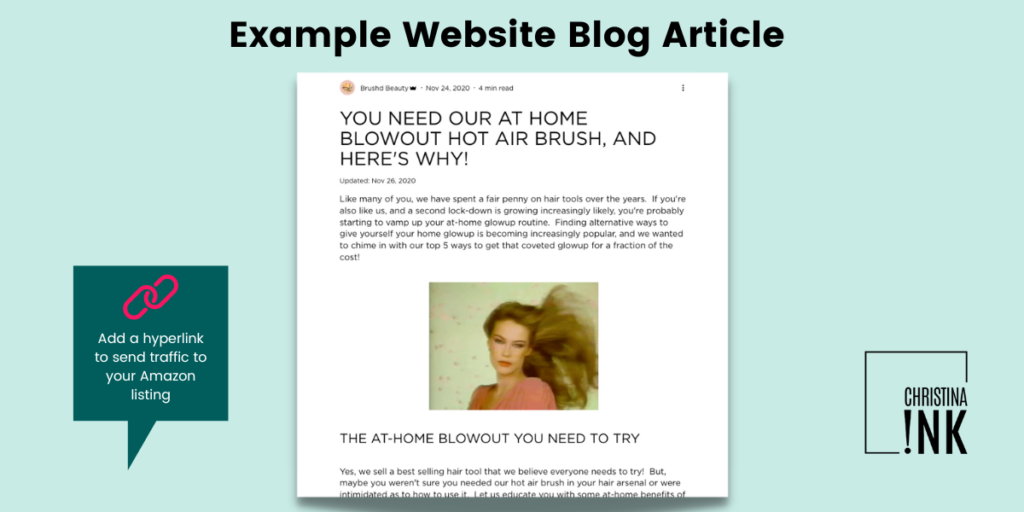Amazon listing optimization tips only get you so far. Picture this: you’ve spent hours and resources finely optimizing your Amazon listing with relevant keywords, captivating images, and compelling product benefits. But short of that, you’re unable to drive traffic, and soon, Amazon deprioritizes your listing, and your optimization efforts are wasted.
To stand out and drive Amazon sales, effective listing marketing and promotion are essential. Learn the top seven strategies to promote your Amazon listing and boost sales below.
Can You Promote Your Amazon Listing?
Absolutely! But success requires proactive steps to promote your listing and ensure it stands out. Amazon offers a range of built-in tools and features, along with external strategies, to help you effectively market and promote your Amazon listings. The first step is always Amazon lisitng optimization. Ensure your listing contains advanced Amazon SEO, stunning visuals, clear product benefits, a succinct title and more. Read our Ultimate Guide to Amazon Listing Optimization.
How Much Does it Cost to Promote a Listing on Amazon?
Promoting your listing involves strategic investment that can yield substantial returns regarding brand awareness, visibility, sales, and overall business growth. The cost of promoting a listing varies based on the methods and tools you choose to employ. Ultimately, the cost of promoting a listing is flexible and scalable based on your budget, goals, and the tools you choose to leverage. It’s important to view these expenses as strategic business investments. Assess the performance of your promotional and marketing efforts and adjust your strategies as needed. Here are our top seven methods to market and promote your Amazon product detail pages:
#1 Amazon PPC Advertising
Amazon’s Pay-Per-Click (PPC) advertising is a dynamic and targeted tool that allows you to promote your products within Amazon’s vast marketplace. The costs associated with Amazon PPC advertising can be managed based on your budget and campaign objectives. Go overboard and risk profits, limit ads and risk visibility. It’s about finding the right balance. Let’s explore the specifics of this powerful advertising method:
- Setting Your Budget: One of the key advantages of Amazon PPC is the ability to set your own budget. Decide how much you are willing to spend on campaigns so you can control costs based on your financial capacity and advertising goals.
- Bidding on Keywords: The cost of Amazon PPC is tied to bidding on relevant keywords. You’ll want to bid on specific keywords related to your products. When shoppers search for these terms, the highest bidder’s ad is displayed. The cost-per-click (CPC) is the amount you pay when a customer clicks on your ad. Keyword selection and bid management are vital factors that influence the overall cost and success of your PPC campaigns.
- Ad Placement: Amazon offers various ad placements, including sponsored product ads, sponsored brand ads, and sponsored display ads. Each ad type has its own cost structure and placement strategy. Sponsored product ads, for instance, appear within search results and product detail pages, while sponsored brand ads appear at the top of search, providing prime visibility to potential customers. You’ll pay different rates depending on the Amazon real-estate you want to appear on.
- Targeting Options: Amazon PPC allows for precise targeting, enabling you to reach a specific audience. You can target ads based on keywords, product categories, customer demographics, and even retarget shoppers who have viewed your products but haven’t made a purchase. Effective targeting enhances the relevance of your ads, potentially increasing click-through rates and conversion rates.
- Campaign Performance Monitoring: Monitoring the performance of your Amazon PPC campaigns is crucial for optimizing costs and maximizing returns. Amazon provides detailed analytics, including impressions, clicks, conversion rates, and advertising spend. By regularly analyzing these metrics, you can identify high-performing keywords, adjust bids, and refine your overall advertising strategy.
- Adjusting Your Strategy: Amazon PPC is not a set-it-and-forget-it tool. Regularly review and adjust your PPC strategy based on performance data. If certain keywords are generating a high return on investment (ROI), consider allocating more budget to those. If certain keywords are underperforming, adjust your bids or pause or negative exact ineffective keywords to reallocate your budget.
- Long-Term Considerations: While managing costs is essential, it’s equally important to view Amazon PPC as a long-term investment. Building a strong presence through consistent advertising can contribute to brand recognition and customer loyalty over time. Consider your advertising strategy as part of your broader business growth plan.
#2 Amazon SEO
What is Amazon SEO? Amazon Search Engine Optimization (SEO) is a powerful Amazon listing optimization tip to help market and promote your listing on Amazon. By strategically optimizing your listing with the best keywords and SEO practises, you can enhance its visibility in search results, increasing the likelihood of attracting ready-to-buy shoppers. Here are some key strategies for effective Amazon SEO:
- Keyword Research and Integration: Begin by conducting thorough keyword research to identify terms relevant to your product. Integrate these keywords seamlessly into your product title, bullet points, and product description. Strategic keyword placement enhances your listing’s relevance to search algorithms, improving its chances of appearing in relevant search queries. We prefer DataDive Tools for keyword research and Amazon SEO.
- Compelling Product Titles: Craft product titles that not only include important keywords but also resonate with your target market. A well-constructed title improves search visibility and entices users to click on your listing. Be clear, concise, leverage power words and highlight key features.
- Optimized Bullet Points and Product Description: Use these sections to provide detailed information focusing on product features and relevant keywords. Respect recommended characters and bytes. Focus on Amazon listing readability to ensure that potential customers can quickly understand the value your product offers.
- Backend Search Terms: Amazon allows sellers to add backend search terms not visible to shoppers to help boost visibility. Include relevant keywords including holiday and seasonal keywords, gifting keywords you could not fit into the forward listing.
- Optimized Product Variations: If your product has variations (such as different colors or sizes), optimize each variation individually to capture a bigger range of search queries. This ensures that customers find exactly what they’re looking for within your product offerings.
#3 Amazon Posts
Amazon Posts are a dynamic Amazon feature that empowers sellers to elevate your product marketing by combining visuals, storytelling, and social interaction within the Amazon platform. This unique tool provides a new dimension to how products are presented, fostering a deeper connection with potential customers. The plus side? Amazon sellers tend to ignore this powerful Amazon listing optimization tip so its a great way to help promote your brand and stand out. Let’s explore the key aspects and strategies to make the most of Amazon Posts to promote and market your products.

- Visual Storytelling: Similar to the Instagram platform, Amazon Posts allow you to display feed posts to resonate with your target audience on the Amazon platforms. Leverage engaging visuals to tell your brand and product story. Capture attention and convey the unique value of your offerings.
- Brand Personality: Infuse your Amazon Post with your unique brand persona. Share behind-the-scenes glimpses and highlight your values to foster a deeper connection with shoppers.
- Cross-Promotional Opportunities: Cross-promote related products without making it obvious you’re promoting. Customers tend to seek authentic social media content, and Amazon posts are no exception. Leverage UGC to showcase various products in use, within your catalog. Be as authentic as possible so shippers feel compelled to choose your brand.
- Hashtag Utilization: Boost discoverability by using relevant hashtags. Research popular hashtags in your niche to expand the reach of your posts. Use the Amazon search bar to unlock different hashtag opportunities.
- Consistent Posting Schedule: Just like on any social media channel, consistent posting is required so shoppers can build trust with your brand. Establish a regular posting schedule to signal activity and build brand recognition. Consistency enhances your brand’s reliability.
- Strategic Product Tagging: Streamline the buying process by using product tagging. Be strategic so your Amazon posts don’t come across disingenuous. Directly link featured products, making it easy for customers to explore and purchase.
- Social Media Integration: Extend your reach by cross posting on external platforms so long as posts resonate on those channels. Leverage social media integration to attract a broader audience beyond the Amazon ecosystem.
- Performance Analytics: Analyze post performance metrics regularly. Gain insights into customer engagement, views, clicks, and click-through rates to refine your content strategy.
#4 Customer Reviews

Customer reviews serve as a powerful marketing tool, shaping perceptions and influencing potential buyers. On Amazon, cultivating positive reviews involves actively encouraging satisfied customers to share their experiences. Utilize Amazon’s “Request a Review” feature to streamline the process, prompting customers to provide feedback after a purchase. Responding thoughtfully to reviews, both positive and negative, showcases a commitment to customer satisfaction.
Beyond the Amazon platform, leverage positive reviews from your e-commerce website and social media interactions and sales to amplify your marketing and promotional efforts. Incorporate customer testimonials into social media campaigns, email newsletters, and your official website to build credibility and trust among a broader audience. Consider creating review-driven content, such as case studies or video testimonials, that highlights authentic customer experiences. Collaborate with influencers and bloggers to garner honest reviews that can introduce your brand to new audiences driving traffic to your Amazon listing and beyond. By strategically incorporating customer reviews from various channels, you’ll create narratives that resonates with potential buyers.
#5 Lightning Deals and Promotions
Lightning Deals and promotions present a compelling opportunity for you to elevate your product visibility, create a sense of urgency and drive sales among Amazon shoppers. Understanding the dynamics of Amazon’s promotional tools and their associated costs is crucial for maximizing their impact on your Amazon business. Considerations include:
- Cost: Participation in Lightning Deals incurs a fee, varying based on factors like product category and promotion duration. While there’s an associated cost, the increased visibility and potential sales boost often justify the investment.
- Limited Urgency: Lightning Deals are time-sensitive, creating urgency among shoppers. By offering significant discounts for a brief period, sellers can drive conversions as customers are motivated to seize the limited-time offer.
- Special Placement: A notable benefit of Lightning Deals is the prime placement on the “Today’s Deals” page, enhancing product visibility. This strategic positioning increases the chances of attracting a broad audience.
- Sales Events: Amazon’s thematic events like Black Friday or Prime Day offer additional opportunities. While competition is fierce, participating in these events can increase exposure and conversion.
- Measuring ROI: Monitor KPIs such as sales, traffic, and conversion rates to assess promotion effectiveness. Calculate ROI by comparing promotional fees to additional revenue generated, informing future participation decisions.
- Post-Promotion Engagement: After a promotion, engage with customers across social channels. Encourage reviews, invite them to join your e-mail marketing list or to follow your brand. Building post-promotion relationships fosters repeat business and loyalty
#6 Social Media Marketing
Leveraging Social Media Marketing (SMM) to promote your Amazon listing involves strategically sharing engaging content, such as stunning visuals, videos, UGC and customer testimonials, across relevant platforms, directing traffic to your Amazon store and creating a cohesive brand presence that resonates with your target audience. Here’s what to consider when leveraging social media marketing to promote your Amazon listing.

- Choosing the Right Platforms: Identify the best social media platforms most relevant to your target demographic. Whether it’s Facebook, Instagram, TikTok, LinkedIn, or others, understanding your audiences preferred channels is vital so you can easily connect with them.
- Crafting Engaging Content: Develop a content strategy that captivates your audience. Share visually appealing images and content that resonates with people at different stages of their buyer journey. Share informative videos, behind the scenes, trends and compelling captions that align with your brand persona. Strive to create content that does not resonate on an emotional level and solves problems.
- Centralized Link Hub: Linktree services like Beacons.ai serve as a centralized hub for all your important links, providing a clean and organized presentation. In the context of promoting your Amazon listing, this allows you to include the direct link to your product page alongside other relevant links, such as your website, blog, or promotional campaigns in the link section of your social media account.
- Utilizing Paid Advertising: Social media platforms offer robust advertising tools. Invest in targeted ads like TikTok ads to reach specific demographics, retarget website visitors, or promote specific products. The ability to customize your audience and budget provides a cost-effective way to enhance visibility and drive traffic.
- Leveraging UGC: Collaborate with UGC creators whose audience aligns with your target market to promote your Amazon listings across your social media channels. User-generated content provides authentic endorsements and taps into established communities. Ensure that partnerships are genuine.
Through strategic platform selection, compelling content creation, community engagement, and a balanced mix of organic and paid strategies, you can harness the influential potential of social media to promote your brand and Amazon listing.
#7 Website Blogging
E-commerce website blogging stands as a dynamic and strategic component of an overarching marketing strategy, particularly when aiming to promote and market your Amazon listings. By incorporating a blog on your e-commerce website, you can harness content marketing to build brand authority, drive traffic and ultimately boost visibility for your Amazon products. Here’s how website blogging can be effectively utilized for the promotion of your Amazon listings:

- Educational and Informative Content: Leverage your website blog to provide valuable and engaging content that promotes your Amazon products naturally.
- Cross-Linking to Amazon Listings: Seamlessly integrate links to your Amazon product listings within your blog content. Ensure that these links are strategically placed within relevant context, guiding readers to explore and make purchases directly from your Amazon store. This cross-linking strategy enhances the visibility of your products and encourages conversions.
- Highlighting Product Features and Use Cases: Leverage your blog to delve deeper into the features, benefits, and various use cases of your Amazon products. Use engaging storytelling and visual elements to showcase how your products solve problems or enhance the lives of your customers. Provide step-by-step instructional content and use links to direct readers to your Amazon listing. Providing comprehensive details can naturally encourage purchases.
- Announcing Product Launches and Updates: Keep your audience informed about new product launches, updates, or enhancements through your blog. Write engaging posts that build anticipation and highlight the unique selling points of your latest offerings. This not only generates excitement but also drives traffic to your Amazon listings when the products become available.
- Promotional Campaigns and Discounts: Use your blog to announce and elaborate on promotional campaigns, discounts, or exclusive deals related to your Amazon products. Blog posts can help create a sense of urgency, encouraging readers to take action and head to your Amazon store.
- Email Marketing Integration: Integrate your blog content into email marketing campaigns. Regularly share blog updates with your email subscribers, directing them to your website where they can find links to your Amazon products. Don’t forget to integrate the Amazon Brand Referral link helping you make commissions from every purchase.
- Social Media Amplification: Share your blog content across your social media channels, amplifying its reach. Craft engaging social media posts that tease the content of your blog and include direct links to your Amazon listings. This cross-channel promotion maximizes exposure and encourages audience interaction.
Website blogging serves as a versatile and impactful tool for marketing and promoting your Amazon listings. By creating valuable, relevant, and engaging content, you can attract organic traffic, enhance your brand’s online presence, and drive conversions on your Amazon storefront. Consistency, strategic linking, and a customer-centric approach will contribute to the success of an integrated marketing strategy.
Marketing Off Amazon is Just As Important As On Amazon
The answer to how to promote your Amazon listing lies in the success of your on and off-Amazon marketing and promotion efforts. Social media marketing not only extends brand presence but also funnels traffic directly to Amazon listings. The strategic use of website blogging and Linktree services bridges platforms, enhancing overall brand visibility offering a centralized hub for user convenience. While, positive customer reviews, irrespective of where they originate, serve as pivotal marketing assets, shaping buyer decisions.
Adaptability and a customer-centric focus are key to navigating the ever-changing landscape and promoting your Amazon listings for lasting success. Try these top seven Amazon listing optimization tips to promote your Amazon listing. Let us know in the comments what tips helped most. We’d love to hear from you.

LIKE THIS ARTICLE?